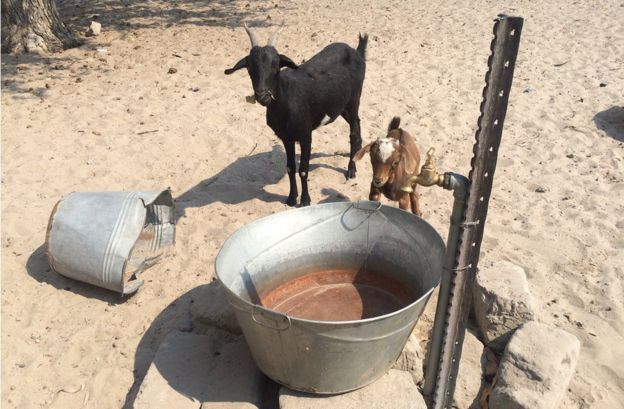Namibia Battling Drought
Published on by Water Network Research, Official research team of The Water Network in Social
Here in Namibia in southern Africa, a drought is intensifying, the soil has been turned into dust and animals are scouring the baked land for something to eat
Monica's village, Omagongati, is in the far north of the country, a region notorious for extremes of weather, but she says that the dry spell hitting her now has been longer and more severe than normal.
"Four of my goats died - there was just nothing to feed them on," she tells me. A few of her surviving goats, gathered around her, are bleating forlornly.
Over the past two years, the weak or absent rains have left Monica among at least 500,000 people needing emergency food aid - and many here are wondering whether climate change will bring an even hotter and drier future.
In the past few months, as the drought has worsened and harvests have failed, the Namibian government has launched a well-rehearsed programme of food deliveries to the hardest-hit areas - droughts are nothing new here.
On the one hand, Namibia's response, much admired in southern Africa, shows how it's possible to cope with potentially dangerous conditions, both now and in the future, if global warming makes things worse.
An early warning system raised the alarm - the El Nino weather phenomenon in the Pacific was always destined to mean less rain here - so people knew what was coming, and then the pre-planned emergency food supplies were sent out.
But, on the other hand, many of Namibia's rural population eke out an impoverished existence on marginal land that's wholly dependent on rain. That means that even small changes in temperature, evaporation and the scale and timing of rainfall could all prove devastating.
A report by the government of Namibia, published in 2011, says the country has seen higher temperatures over the past 40 years with more days recorded over 35C.
And it also highlights with a "high degree of certainty" that warming will continue, so that by mid-century it will be up to 3.5C hotter in the summer and up to 4C in the winter.
On rainfall, the study is far less conclusive - computer models have always had more difficulty coming up with projections for precipitation than for temperature.
Fewer consecutive wet days have been observed, the report says. In other words, there have been longer dry spells.
But in future there may be an increase in rainfall, which at first sight sounds positive, except that the rain itself is likely to become more intense, which may in turn exacerbate the risk of flooding, especially if it falls on dry ground.
The prospect of tougher times ahead has prompted the launch of a nationwide drive to teach Namibian children new farming techniques that should help them adapt.
At the Mwadinomho Combined School near Odangwa, I watched a class standing around a small plot of land where a micro-drip irrigation system was at work with a network of narrow pipes feeding two long lines of plants.
Standing under the midday sun, the pupils heard how the plants are grown in black plastic sacks which limit the surface area of soil from which water can evaporate and also concentrates nutrients around the roots where they are needed.
Hilma Shipahu, who heads the school's department that runs the agriculture classes, said she was convinced that the project was vital for the sake of the next generation.
"Each and every year we get some changes and we don't really get enough rain.
"We are always talking about drought, drought, drought and so on, and then in the next 2-3 years to come we don't know if we are going to get a single drop of rain.
Source: BBC
Read More Related Content On This Topic - Click Here
Media
Taxonomy
- Scarcity
- Drought
- Climate Change